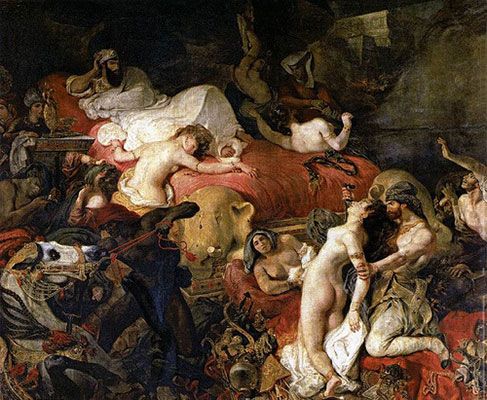Gothic, romatnticism, Victorian-era articles and timelines.
Timeline
Table of Events
| Date | Event | Created by |
|---|---|---|
| 1770 to 1890 | Romanticism (Romantic Era)The Romantic Era began in1770, but reached its peak between 1800 and 1890. This era produced and inspired some of the worlds greatest works of visual art, music, literateratue, and poetry. It was an intellectual movement that orginated in Europe, and was characterized by its emphasis on emotion and individualism. It also glorified the past and nature. The Romantic Era was a response of many world changing events that came before it, such as The Industrial Revolution, The French Revolution, and The Age of Enlightenment. Aesthetics or esthetics, which is a branch of philosophy that deals with the nature of beauty and taste as well as philosophy of art, was emphisized and said to be the source of intense emotion. Apprehension, horror and terror, and awe were the emotions that were highlighted during this time period. The romantic movement originated in Germany, which mirrored intuition and emotion to that of rationalism and enlighenment, which was the infuences of the French Revolution. Artists such as William Blake, Franscisco Goya, William Wordsworth, Caspar David Friedrich, and Eugene Delacroix, to name a few, portrayed the imortance of free expression in their works, which was one of the primary focuses of romaticism. I, Lucy Snowe, dare not to imagine a life without the influence of my dearest friend, Dr. John. Although my clandestine efforts to thwart the love he has for Genevra somewhat failed, he and Mrs. Bretton has not ceased in showing me a life past the dreary and dreadful walls of my colorless life. Blessed are the days that I could gaze upon the drawings of such influential artists or my ears be witness to the most beatiful of melodies. With each visit to the theatre my decorum improved vastly from that of the shy English girl who first wondered the streets of Villette. For a fortnite I have had the priviledge to spend my vacation with the Bretton's at La Terrassee, and with this I have traveled to gallery quite a bit to familiar myself with the portraits it held. They all evnoked a feeling of emotion, most of which I have never felt before looking upon them. One that I remeber so well was sturated with crimson and the portrait reveled the most intimate parts of a woman. The room was full of these women and men who gaze upon them with horses and heroic men. Confusing I know, but captivating none the less. My cheeks grew rosy from such vile and seductive portrayal of woman. "Death of Sardanapalus" was the title of the painting. It was said to have been done by and extemely notable artist of the time called Eugene Delacroix. I can't imgine I will continue to be introduced to such amazing things upon my return to Madame Beck and her watchful eye, until then I shall enjoy all that I can.
Works Cited Romanticism. Wikipedia, Wikimedia Foundation, September 21, 2020, en.wikipedia.org/wiki/Romanticism. Accessed September 23, 2020. |
Chrissy Dandy |
| 9 Nov 1799 | End of the French RevolutionThe cause of The Revolution was a handful of struggles for the French people including that the Empire stipped the fiscal resources of the state, the political conflict between the nobility and the monarchy because of the tax system and eventual bankruptcy. Plus the new ideas that were born of The Enlightenment including Montequieu’s Spirit of the Laws; introduces and Rousseau’sSocial Contract. It lasted a decade with the conclusion being Napoleon causing a coup and becoming First Consul of the Republic.
|
Lindsay Hickman |
| circa. 1800 | Gothic Revival In the ChurchesIn the early 1800s, a Gothic Revival was occurring in the churches within London city limits. The architecture was becoming popular again as the wave of religion was sweeping society. However, Evangelical Protestants initially rejected this movement because they didn't want to be associated with the Roman Catholic religion. They viewed themselves as reformed and did not want to be involved with the past actions of the Roman Catholic church. In the city, many of the churches were being reformed to gothic architecture but churches in the country were not being redesigned at all. This can be seen in Bleak House when Esther attends a church that she describes as solemn, dark, and small. This could be because of the Church of England's resistance toward the Gothic revival.
|
Emma Raimondi |
| 28 Jun 1838 | Queen VictoriaQueen Victoria began her reign after her coronation on June 28, 1838. This was the beginning of a 63 year long reign as monarchy which is the longest reign of any British monarch to date. Her husband, Prince Albert, greatly influenced how she ruled as monarch. Victoria loved and respected him as he helped change her habits and her political sympathies as well as training in how to conduct business, maintain the ministry of home life, and in establishing a private intelligence service abroad. Queen Victoria’s reign was marked by important improvements within Britain. A few important improvements include accelerated industrial, political, and military progress. These progressions are part of the reason why an era was named after Victoria. She was a queen who desired to keep political power as a monarch and was reigning during the transformation of the sovereign’s political role into a ceremonial role. Victoria believed that the sovereign had an important and active role in in British politics. The sovereign’s role in foreign affairs and in keeping alliances held sincere importance. Queen Victoria marked the end of the Romantic period.
Sources: http://www.keats-shelley-house.org/en/romanticism/timeline-1837 https://www.britannica.com/biography/Victoria-queen-of-United-Kingdom |
Victoria Heltzel |

